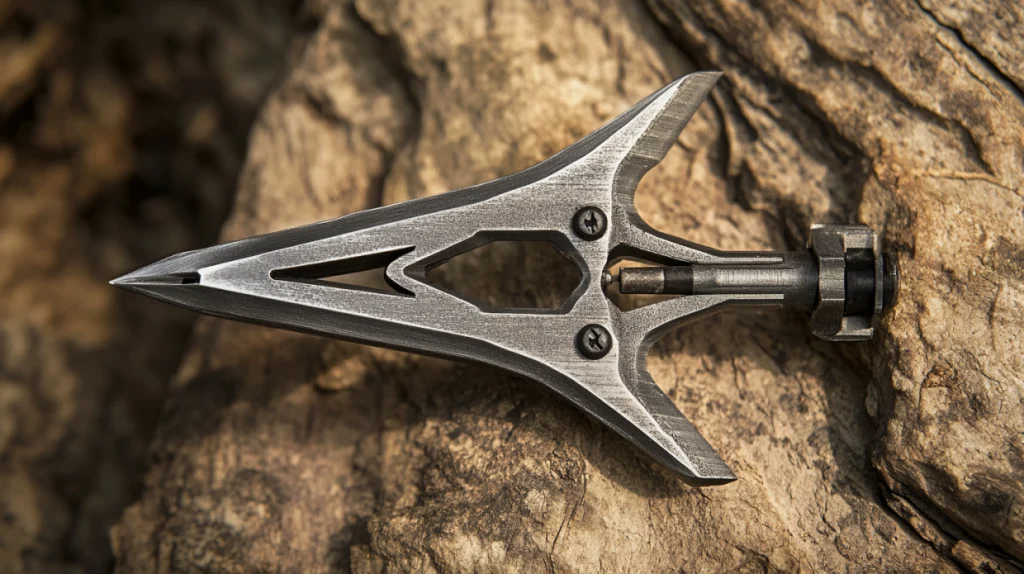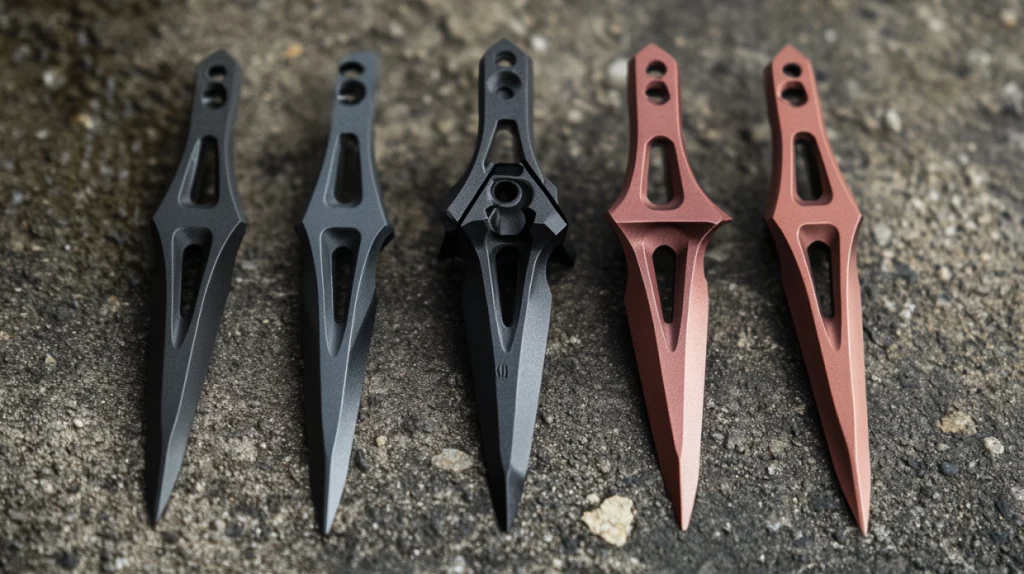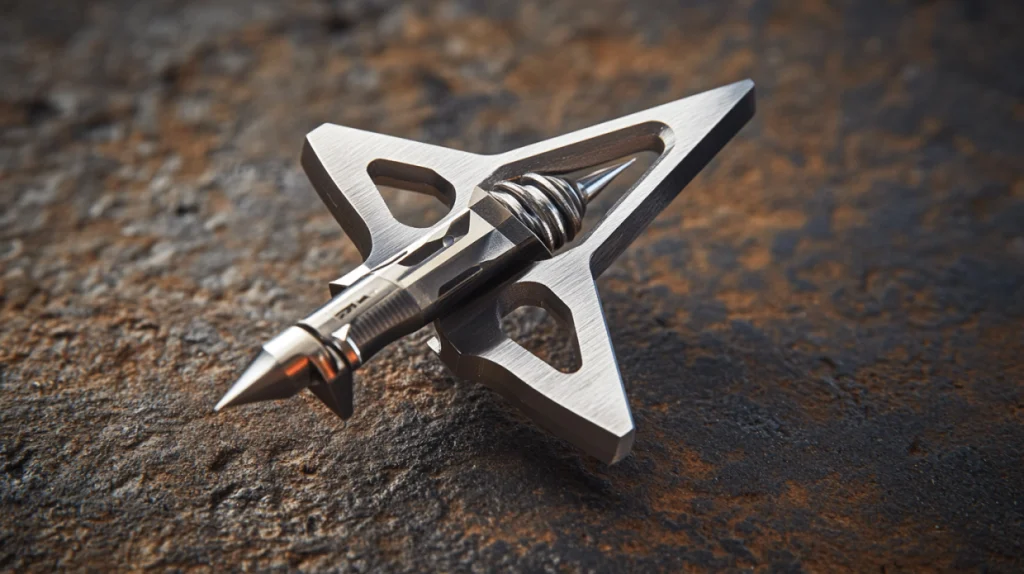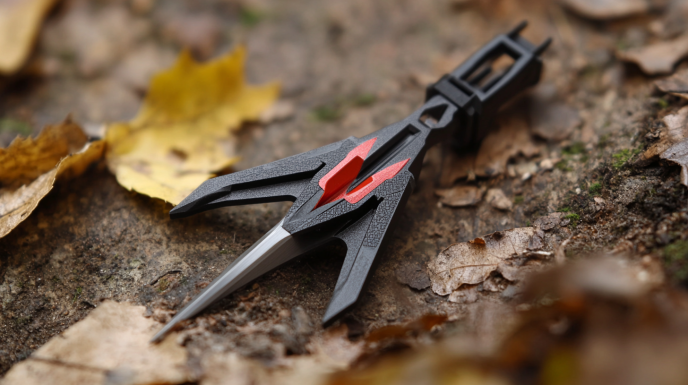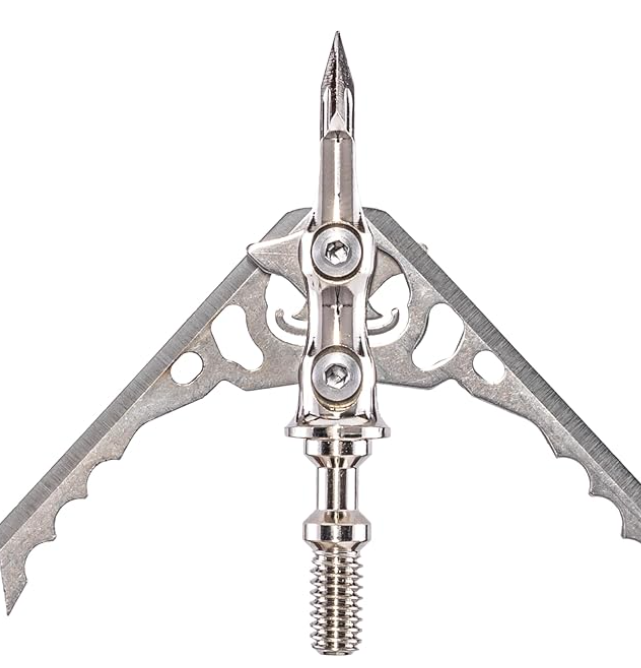
Rage Hypodermic NC 2-Blade 100gr Hunting Broadhead (R38100), Hybrid Tip, No Collar Blade Lock.035” Thick Swept-Back Angled Blades with a 2” Cutting Diameter, Machined Stainless Steel Ferrule, 3-Pack
- PRECISION – Rage broadheads are known for their pinpoint accuracy, extreme penetration, and their wound channels are legendary
- SUPERIOR AERODYNAMICS – This broadhead sports a machined stainless steel ferrule for superior aerodynamics
From Field to Trophy Wall: A Comprehensive Guide to Archery’s Most Lethal Innovation
When I first held a Rage Hypodermic Broadhead in my palm five years ago, I knew immediately that my bowhunting experience would never be the same. The sleek, surgical design promised something that many broadheads before it had claimed but few had delivered: true field-point accuracy with devastating terminal performance. After sending countless arrows downrange and tracking dozens of clean harvests across multiple hunting seasons, I can confidently say that Rage Hypodermic Broadheads have fundamentally transformed the expectations hunters should have for their archery equipment.
But what exactly makes these broadheads so special? Why have they developed such a cult-like following among serious bowhunters? And most importantly—are they worth their premium price tag? This comprehensive guide will answer all your burning questions about one of archery’s most revolutionary innovations.
The Anatomy of Innovation: What Sets Rage Hypodermic Broadheads Apart
The genius of the Rage Hypodermic lies in its unique design philosophy. Unlike traditional fixed-blade broadheads that can plane and affect arrow flight, or early mechanical broadheads that sacrificed penetration for cutting diameter, the Hypodermic offers a near-perfect compromise that leverages the best of both worlds.
The distinctive feature that separates Hypodermic broadheads from competitors is their sleek, hybrid trocar tip that mimics the profile of a hypodermic needle—hence the name. This chisel-point design initiates penetration with surgical precision, while the rear-deploying mechanical blades remain safely tucked during flight but deploy upon impact for devastating wound channels.
The ferrule is machined from solid aircraft-grade aluminum, providing structural integrity without unnecessary weight. When paired with their proprietary ShockLock technology (the small rubber collars that prevent premature blade deployment), you have a broadhead that flies true and hits hard—exactly what every bowhunter dreams of.
Acquisition: Where to Purchase and What to Expect Price-Wise
For those looking to add Rage Hypodermic Broadheads to their hunting arsenal, you have several purchasing options. Most major outdoor retailers carry them, including Cabela’s, Bass Pro Shops, Scheels, and Academy Sports. For those who prefer online shopping, Amazon, Midway USA, and specialized archery retailers like Lancaster Archery Supply offer competitive pricing and often ship directly to your door.
Cost is always a consideration for hunters investing in quality equipment. Rage Hypodermic Broadheads typically retail between $44.99 and $54.99 for a standard pack of three, depending on the specific model and grain weight you choose. This puts them in the premium broadhead category—significantly more expensive than basic fixed-blade options but comparable to other high-end mechanical offerings from companies like Sevr, G5, or NAP.
While this price point might initially cause sticker shock for hunters accustomed to budget broadheads, the investment becomes easier to justify when considering their performance and potential reusability (more on that later). Additionally, seasonal sales during the off-season or package deals that include replacement blades can offer significant savings for the budget-conscious archer.
Technical Specifications: Understanding What You’re Getting
When evaluating broadheads, the devil is in the details. The standard Rage Hypodermic features an impressive 2-inch cutting diameter when fully deployed—creating wound channels that maximize blood trails and reduce tracking distances. This substantial cutting surface exceeds many competing broadheads, which typically offer 1.5 to 1.75-inch diameters.
Weight options include 100-grain (the most popular choice for compound bow hunters) and 125-grain variants, suitable for traditional archers or those seeking more front-of-center weight distribution. The Hypodermic +P model, designed specifically for crossbow hunters or those using higher-draw-weight compounds, comes in 100-grain and 125-grain options with a reinforced ferrule for enhanced durability.
The two-blade design strikes an excellent balance between cutting surface area and penetration potential, with blades measuring 0.035 inches thick—robust enough to resist bending while remaining razor-sharp. Each broadhead comes pre-assembled with Rage’s patented ShockLock technology, which prevents blade deployment during flight or when brushing against obstructions in hunting scenarios.
Durability and Reusability: Getting Your Money’s Worth
One common question among potential buyers concerns reusability—an important consideration given the premium price point. The straightforward answer is yes, Rage Hypodermic Broadheads are designed to be reused, but with some important caveats.
The ferrule, constructed from aircraft-grade aluminum, can typically withstand multiple impacts unless you hit something particularly unyielding (like a rock or bone). The blades, however, are consumable components designed to be replaced after use. Rage sells replacement blade kits separately, allowing you to refresh your broadheads without purchasing entirely new units.
After a successful harvest, careful inspection is necessary. Check the ferrule for straightness, examine the deployment mechanism for proper function, and replace the blades if they show any signs of dulling, nicks, or bending. With proper maintenance, many hunters report using the same Hypodermic ferrules for multiple seasons, maximizing the return on their investment.
A practical tip from my own experience: carry pre-assembled replacement blades in your hunting pack. Nothing is more frustrating than damaging a broadhead on an early season hunt and not having the ability to quickly rebuild it in the field.
Hypodermic vs. Chisel Tip: Understanding the Rage Family Tree
Navigating Rage’s product lineup can be confusing for first-time buyers. The Hypodermic and Chisel Tip models represent different design philosophies within the brand’s catalog.
The Hypodermic features the distinctive needle-like tip that gives it its name, creating a sleek, streamlined profile that initiates penetration before blade deployment. This design prioritizes entry wound efficiency and flight characteristics that closely mimic field points.
In contrast, the Rage Chisel Tip employs a more traditional chisel-point design that’s optimized for bone-breaking capability. While still effective, the Chisel Tip doesn’t quite match the field-point-like flight characteristics of the Hypodermic, though some hunters prefer its durability when impacts with heavy bone are likely.
If surgical precision and field-point accuracy are your primary concerns, the Hypodermic remains the superior option. However, for hunters pursuing larger game where bone encounters are inevitable, the Chisel Tip’s robust construction might provide additional confidence.
Installation and Setup: Maximizing Accuracy and Performance
Proper installation of Rage Hypodermic Broadheads is straightforward but requires attention to detail. Begin by ensuring your arrows are properly spined for your bow’s draw weight and that inserts are securely glued in place.
To install:
- Remove the protective plastic cover from the broadhead
- Carefully check that the ShockLock collar is properly seated
- Verify that blades are fully retracted in the closed position
- Thread the broadhead onto your arrow’s insert, tightening until secure
- Use a broadhead wrench (not pliers) for final tightening to avoid damage
For optimal accuracy, I strongly recommend shooting practice rounds with your hunting setup. While Hypodermics are renowned for flying like field points, subtle variations in bow tuning, arrow construction, and release technique can affect point of impact.
A critical yet often overlooked step is checking arrow spin after installation. Roll your assembled arrow on a flat surface to confirm there’s no wobble, which would indicate an alignment issue. This simple test can prevent frustrating accuracy problems that might otherwise be blamed on the broadheads themselves.
Game Suitability: From Whitetails to Wapiti
Rage Hypodermic Broadheads have earned their reputation primarily in the whitetail woods, where their expansive cutting diameter creates substantial blood trails that make tracking wounded deer significantly easier. The 2-inch wound channel is particularly effective on deer-sized game, where vital organs are clustered in a relatively small area.
But what about larger, more challenging quarry? The question of elk suitability comes up frequently among western hunters. In my experience and based on numerous accounts from experienced elk hunters, Hypodermic broadheads are indeed capable of ethically harvesting elk when used with properly spined arrows and adequate kinetic energy. However, the standard Hypodermic may not be the optimal choice for the largest big game animals.
For elk, moose, or other large-bodied game, consider stepping up to the Hypodermic +P model, which features a reinforced ferrule specifically designed for increased durability against larger animals. Additionally, opting for the 125-grain variant will provide additional momentum for deeper penetration through the thicker hide and denser muscle mass of these larger species.
The general rule of thumb: match your broadhead to both your quarry and your setup. A properly tuned 70-pound compound delivering a heavy arrow tipped with a Hypodermic +P is absolutely elk-capable, while lighter setups might be better served sticking to deer-sized game.
Comparative Analysis: Hypodermic vs. The Competition
The mechanical broadhead market has become increasingly crowded, with each manufacturer claiming superior performance. How do Rage Hypodermics stack up against popular alternatives like Muzzy and Grim Reaper?
Compared to Muzzy’s primarily fixed-blade offerings, Hypodermics generally provide substantially larger cutting diameters and better flight characteristics, especially at longer ranges. However, Muzzy broadheads typically offer better penetration on quartering shots due to their fixed-blade construction and may be more durable for repeated use.
Grim Reaper broadheads present a more direct comparison as they’re also mechanical. The primary difference lies in deployment mechanisms and cutting configurations. While Grim Reapers use a “spring clip” system for deployment, Rage utilizes their slip-cam design which requires less energy to fully open, potentially allowing more kinetic energy to transfer to penetration.
In field testing across multiple seasons, I’ve found that Rage Hypodermics consistently outperform both brands in creating visible, easy-to-follow blood trails—often the most crucial factor in successful recovery. However, both Muzzy and Grim Reaper typically cost less per broadhead, making them attractive options for hunters on tighter budgets.
Legal Considerations: Know Before You Go
Before investing in any broadheads, understanding local hunting regulations is essential. While Rage Hypodermic Broadheads are legal in most hunting jurisdictions across the United States, some specific states and counties have restrictions on mechanical broadheads or minimum cutting diameter requirements.
As of my last verification, Oregon and Washington have specific regulations regarding mechanical broadheads in certain hunting situations. A handful of other states have minimum cutting diameter requirements, though the Hypodermic’s 2-inch deployed diameter easily exceeds these minimums (typically set at 7/8″ or 1″).
For international hunters, regulations vary widely. Several Canadian provinces have restrictions on mechanical broadheads for certain game species. Always check with your local wildlife agency before heading afield, as regulations can change annually and violations can result in significant penalties.
Materials and Construction: Engineering Excellence
The exceptional performance of Rage Hypodermic Broadheads stems directly from their materials and construction quality. The ferrule is precision-machined from solid aircraft-grade aluminum, providing the optimal balance between structural integrity and weight efficiency.
The blades themselves deserve special attention. Constructed from stainless steel and precision-ground to a surgically sharp edge, they maintain their cutting ability even after passing through tough hide and muscle tissue. At 0.035 inches thick, they’re substantial enough to resist bending while remaining thin enough to slice efficiently.
The patented SlipCam deployment mechanism represents a significant engineering achievement. Unlike broadheads that rely on O-rings or rubber bands that can deteriorate over time, the SlipCam design uses the resistance of animal hide itself to initiate deployment, ensuring consistent operation regardless of weather conditions or storage duration.
Compatibility with Modern Archery Equipment
Modern compound bows frequently generate arrow speeds exceeding 300 feet per second, creating potential issues for some mechanical broadheads that may deploy prematurely or experience accuracy problems at high velocities. Rage Hypodermic Broadheads, however, are specifically designed to maintain stability at these increased speeds.
The ShockLock technology is particularly important here—the small rubber collar prevents the blades from deploying during acceleration or flight, regardless of how much energy your compound bow is generating. This makes Hypodermics an excellent choice for archers using high-performance, speed-oriented bow setups.
Crossbow hunters face similar considerations with even higher velocities, often exceeding 400 FPS. For these applications, Rage offers the specialized Hypodermic +P Crossbow model, featuring additional ferrule reinforcement and blade retention mechanisms specifically engineered for the increased stresses of crossbow shooting.
The Voice of Experience: What Real Hunters Say
Beyond technical specifications and marketing claims, real-world performance is the ultimate test of any hunting equipment. Across forums, social media groups, and hunting camps, Rage Hypodermic Broadheads consistently receive praise from everyday hunters who stake their success on their performance.
Common themes in positive reviews include:
- Exceptional accuracy, particularly at longer hunting distances
- Devastating wound channels that create substantial blood trails
- Reliable deployment even in less-than-perfect shot scenarios
- Impressive penetration despite the mechanical design
Criticisms typically center around:
- Higher price point compared to fixed-blade alternatives
- Occasional durability issues when impacting heavy bone
- The need to purchase replacement blades adds to long-term cost
In my own experience spanning over 20 successful harvests with Hypodermics, the broadheads have performed exactly as advertised in all but the most extreme circumstances. The few failures I’ve witnessed were primarily due to poor shot placement rather than equipment malfunction—a reminder that even the best broadheads can’t compensate for fundamental shooting errors.
Maintenance and Replacement: Keeping Your Edge
To maximize the lifespan and performance of your investment, proper maintenance is essential. After each use, disassemble the broadhead completely and clean all components thoroughly, removing any tissue, blood, or debris. A light application of oil on metal surfaces prevents corrosion during storage.
Replacement blades are readily available from the same retailers that sell the complete broadheads. A standard replacement blade kit typically costs between $24.99 and $29.99 for a pack that will refresh three broadheads. This represents a significant savings compared to purchasing entirely new units.
When inspecting used broadheads, pay particular attention to:
- Blade edge integrity—even microscopic nicks can affect penetration
- Ferrule straightness—any bending will compromise accuracy
- Deployment mechanism function—test the action before trusting it afield
- ShockLock collar condition—replace if showing signs of wear or damage
Hypodermic vs. Trypan: Evolution of Excellence
As Rage continues to refine their offerings, the introduction of the Trypan model has created some confusion among hunters familiar with the Hypodermic. While both share DNA, there are meaningful differences worth understanding.
The Trypan represents an evolution of the Hypodermic concept, featuring a one-piece stainless steel ferrule (compared to the Hypodermic’s aluminum construction) and the upgraded “High Energy Shock Collar” that provides even more secure blade retention. The Trypan maintains the same 2-inch cutting diameter but incorporates thicker .039″ blades compared to the Hypodermic’s .035″ blades.
For most hunting applications, these differences translate to marginal performance improvements at a higher price point. The Trypan excels in extreme conditions and on larger game, while the Hypodermic remains more than adequate for standard deer hunting scenarios. Consider the Trypan an upgrade rather than a replacement—a premium option for those seeking the absolute pinnacle of mechanical broadhead technology.
Crossbow Compatibility: Special Considerations
The growing popularity of crossbow hunting has created demand for specialized broadheads capable of handling the extreme velocities and higher kinetic energy these weapons generate. Standard Rage Hypodermics can be used with crossbows but may experience accelerated wear or potential deployment issues at the highest speeds.
For dedicated crossbow hunters, Rage offers the Hypodermic +P Crossbow variant, specifically designed with:
- Reinforced ferrule construction to withstand increased impact forces
- Enhanced ShockLock collars that prevent premature deployment at speeds exceeding 400 FPS
- Increased blade thickness for durability during high-energy impacts
The crossbow-specific models typically cost approximately $5-10 more per pack than standard Hypodermics, but this premium is justified by their specialized construction and enhanced reliability in crossbow applications.
Achieving Field-Point Accuracy: Tuning Tips and Techniques
While Rage Hypodermics are renowned for their field-point-like flight characteristics, achieving optimal accuracy requires proper bow tuning and setup. The most common accuracy issues stem not from the broadheads themselves but from inconsistencies in the archer’s overall system.
For best results:
- Begin with a properly paper-tuned bow showing clean arrow flight
- Ensure arrow spine is correctly matched to your draw weight and length
- Verify that arrow inserts are squarely installed without deviation
- Confirm broadheads are spin-tested and thread straight onto inserts
- Practice at realistic hunting distances to understand point of impact differences
If you notice inconsistency between your field points and Hypodermics, avoid the temptation to use different sight pins. Instead, focus on resolving the underlying tuning issue—a properly set up bow should group broadheads and field points together at hunting distances.
Final Verdict: Are They Worth the Investment?
After thousands of hours in the field, countless discussions with fellow hunters, and objective analysis of performance metrics, I believe Rage Hypodermic Broadheads represent one of the most significant innovations in modern bowhunting technology. Their combination of flight characteristics, deployment reliability, and wound channel effectiveness places them among the elite options available to today’s hunter.
The premium price point remains the primary barrier for many archers, particularly those new to bowhunting or operating on limited budgets. However, when considering the potential cost of lost game due to inferior equipment—both financial and ethical—the investment becomes easier to justify.
For serious hunters who prioritize clean, ethical harvests and minimal tracking distances, Rage Hypodermic Broadheads deliver performance that genuinely justifies their premium positioning in the market. While not the most economical option available, they represent the intersection of innovation and effectiveness that has rightfully earned them their place in hunting packs across the country.
Whether you’re a veteran bowhunter looking to upgrade your terminal performance or a newcomer seeking equipment that maximizes your chances of success, Rage Hypodermics deserve serious consideration. Their reputation isn’t built on marketing hype but on consistent field performance when it matters most—at the moment of truth when your season hangs in the balance.
The cutting edge isn’t just about sharpness—it’s about staying ahead of the competition. In the world of mechanical broadheads, Rage Hypodermics continue to define what’s possible when engineering excellence meets hunting practicality.

